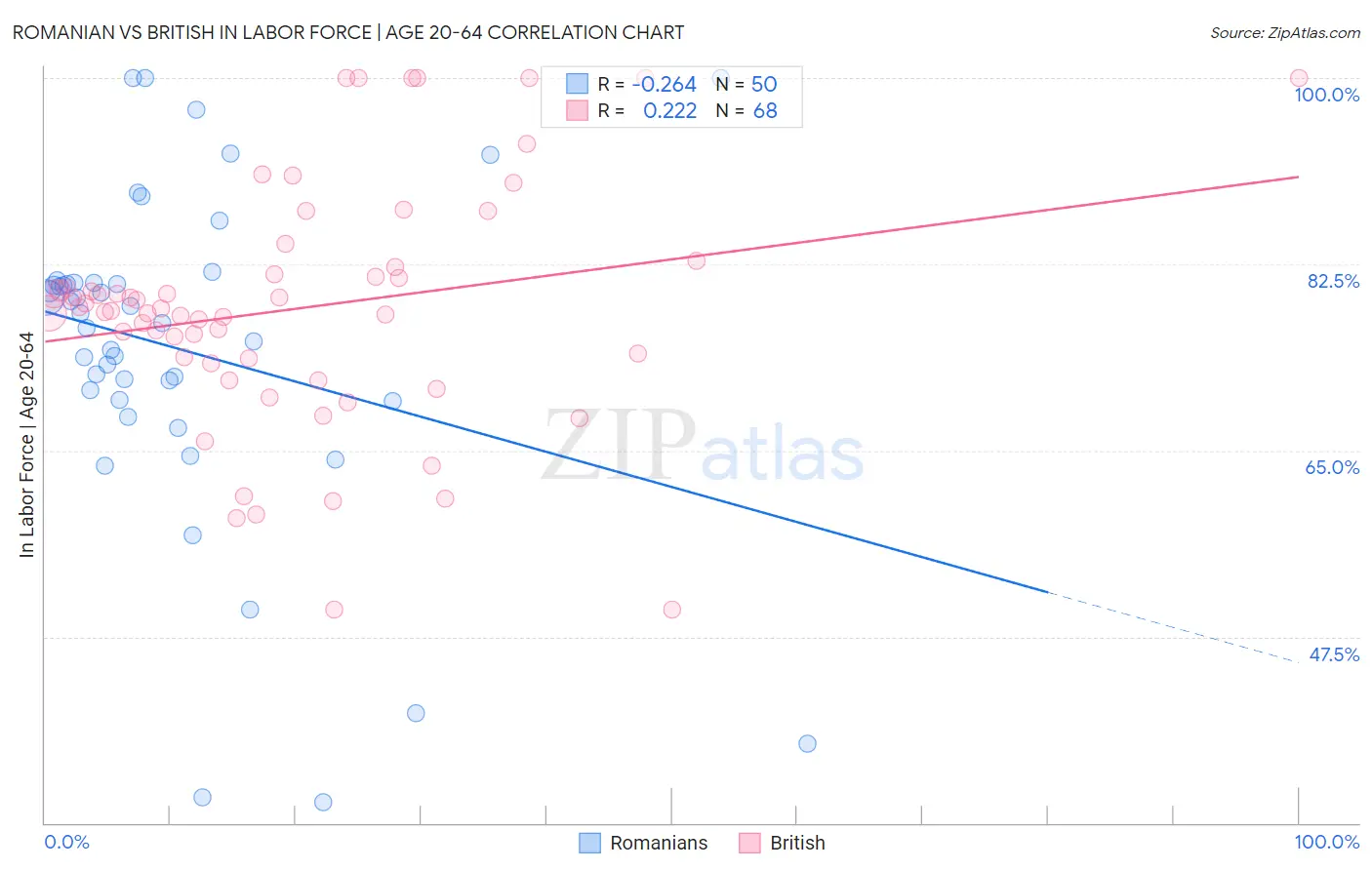Romanian vs British In Labor Force | Age 20-64
COMPARE
Romanian
British
In Labor Force | Age 20-64
In Labor Force | Age 20-64 Comparison
Romanians
British
79.8%
IN LABOR FORCE | AGE 20-64
77.6/ 100
METRIC RATING
148th/ 347
METRIC RANK
79.3%
IN LABOR FORCE | AGE 20-64
16.5/ 100
METRIC RATING
208th/ 347
METRIC RANK
Romanian vs British In Labor Force | Age 20-64 Correlation Chart
The statistical analysis conducted on geographies consisting of 377,918,924 people shows a weak negative correlation between the proportion of Romanians and labor force participation rate among population between the ages 20 and 64 in the United States with a correlation coefficient (R) of -0.264 and weighted average of 79.8%. Similarly, the statistical analysis conducted on geographies consisting of 531,500,819 people shows a weak positive correlation between the proportion of British and labor force participation rate among population between the ages 20 and 64 in the United States with a correlation coefficient (R) of 0.222 and weighted average of 79.3%, a difference of 0.58%.

In Labor Force | Age 20-64 Correlation Summary
| Measurement | Romanian | British |
| Minimum | 31.9% | 50.0% |
| Maximum | 100.0% | 100.0% |
| Range | 68.1% | 50.0% |
| Mean | 74.5% | 78.3% |
| Median | 77.4% | 78.2% |
| Interquartile 25% (IQ1) | 69.8% | 73.4% |
| Interquartile 75% (IQ3) | 80.7% | 81.9% |
| Interquartile Range (IQR) | 10.9% | 8.6% |
| Standard Deviation (Sample) | 15.5% | 11.4% |
| Standard Deviation (Population) | 15.3% | 11.3% |
Similar Demographics by In Labor Force | Age 20-64
Demographics Similar to Romanians by In Labor Force | Age 20-64
In terms of in labor force | age 20-64, the demographic groups most similar to Romanians are Immigrants from Philippines (79.8%, a difference of 0.0%), Korean (79.8%, a difference of 0.020%), Pakistani (79.8%, a difference of 0.020%), Immigrants from Southern Europe (79.8%, a difference of 0.020%), and Immigrants from Israel (79.8%, a difference of 0.030%).
| Demographics | Rating | Rank | In Labor Force | Age 20-64 |
| Immigrants | Israel | 80.0 /100 | #141 | Good 79.8% |
| Slovaks | 79.9 /100 | #142 | Good 79.8% |
| Immigrants | Sweden | 79.7 /100 | #143 | Good 79.8% |
| Koreans | 79.6 /100 | #144 | Good 79.8% |
| Pakistanis | 79.3 /100 | #145 | Good 79.8% |
| Immigrants | Southern Europe | 78.9 /100 | #146 | Good 79.8% |
| Immigrants | Philippines | 78.0 /100 | #147 | Good 79.8% |
| Romanians | 77.6 /100 | #148 | Good 79.8% |
| Icelanders | 75.1 /100 | #149 | Good 79.7% |
| Costa Ricans | 72.4 /100 | #150 | Good 79.7% |
| Scandinavians | 72.0 /100 | #151 | Good 79.7% |
| Immigrants | Northern Europe | 72.0 /100 | #152 | Good 79.7% |
| Immigrants | Kazakhstan | 69.5 /100 | #153 | Good 79.7% |
| New Zealanders | 69.4 /100 | #154 | Good 79.7% |
| Immigrants | South Africa | 69.2 /100 | #155 | Good 79.7% |
Demographics Similar to British by In Labor Force | Age 20-64
In terms of in labor force | age 20-64, the demographic groups most similar to British are Subsaharan African (79.3%, a difference of 0.0%), Bangladeshi (79.3%, a difference of 0.0%), Immigrants from Ecuador (79.3%, a difference of 0.010%), Haitian (79.3%, a difference of 0.010%), and Iraqi (79.3%, a difference of 0.020%).
| Demographics | Rating | Rank | In Labor Force | Age 20-64 |
| Immigrants | Nicaragua | 19.0 /100 | #201 | Poor 79.3% |
| Nicaraguans | 18.3 /100 | #202 | Poor 79.3% |
| Iraqis | 17.7 /100 | #203 | Poor 79.3% |
| Immigrants | Cambodia | 17.6 /100 | #204 | Poor 79.3% |
| Immigrants | Congo | 17.5 /100 | #205 | Poor 79.3% |
| Immigrants | Ecuador | 16.9 /100 | #206 | Poor 79.3% |
| Sub-Saharan Africans | 16.5 /100 | #207 | Poor 79.3% |
| British | 16.5 /100 | #208 | Poor 79.3% |
| Bangladeshis | 16.4 /100 | #209 | Poor 79.3% |
| Haitians | 16.1 /100 | #210 | Poor 79.3% |
| Europeans | 15.3 /100 | #211 | Poor 79.3% |
| Irish | 13.2 /100 | #212 | Poor 79.3% |
| Immigrants | Portugal | 12.8 /100 | #213 | Poor 79.3% |
| Immigrants | Armenia | 12.2 /100 | #214 | Poor 79.2% |
| Immigrants | Norway | 12.0 /100 | #215 | Poor 79.2% |